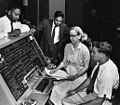Portal:Computer programming
The Computer Programming Portal
Computer programming or coding is the composition of sequences of instructions, called programs, that computers can follow to perform tasks. It involves designing and implementing algorithms, step-by-step specifications of procedures, by writing code in one or more programming languages. Programmers typically use high-level programming languages that are more easily intelligible to humans than machine code, which is directly executed by the central processing unit. Proficient programming usually requires expertise in several different subjects, including knowledge of the application domain, details of programming languages and generic code libraries, specialized algorithms, and formal logic.
Auxiliary tasks accompanying and related to programming include analyzing requirements, testing, debugging (investigating and fixing problems), implementation of build systems, and management of derived artifacts, such as programs' machine code. While these are sometimes considered programming, often the term software development is used for this larger overall process – with the terms programming, implementation, and coding reserved for the writing and editing of code per se. Sometimes software development is known as software engineering, especially when it employs formal methods or follows an engineering design process. (Full article...)
Selected articles -
Selected images
Did you know? -

- ... that the study of selection algorithms has been traced to an 1883 work of Lewis Carroll on how to award second place in single-elimination tournaments?
- ... that Brazilian computer science researcher and internet pioneer Tadao Takahashi negotiated with drug lords to install internet equipment in his country?
- ... that a "hacker" with blog posts written by ChatGPT was at the center of an online scavenger hunt promoting Avenged Sevenfold's album Life Is but a Dream...?
- ... that the software-testing framework pytest has been described as a key ecosystem project for the Python programming language?
- ... that it took a particle accelerator and machine-learning algorithms to extract the charred text of PHerc. Paris. 4 without unrolling it?
- ... that the 2024 psychological horror game Mouthwashing utilises non-diegetic scene transitions that mimic glitches and crashes?
Subcategories
WikiProjects
- There are many users interested in computer programming, join them.
Computer programming news
- 21 January 2025 – Infrastructure policy of Donald Trump
- U.S. President Donald Trump unveils a joint venture between OpenAI, Oracle, and SoftBank, called Stargate. With planned funding of up to $500 billion in the next four years, the project aims to build data centers and computing infrastructure across the United States to power AI development and create over 100,000 jobs. (The Guardian)
- 21 January 2025 –
- U.S. President Donald Trump pardons Ross Ulbricht, the creator of the Silk Road. Ulbricht was serving a life sentence for charges including conspiracy to commit money laundering, hacking, and drug trafficking. (Axios)
- 17 January 2025 – 2024 United States telecommunications hack
- The U.S. Treasury Department sanctions a cybersecurity company and hacker, both with ties to China's Ministry of State Security, for their alleged roles in hacking American telecommunications companies. (Reuters)
Topics
Related portals
Associated Wikimedia
The following Wikimedia Foundation sister projects provide more on this subject:
-
Commons
Free media repository -
Wikibooks
Free textbooks and manuals -
Wikidata
Free knowledge base -
Wikinews
Free-content news -
Wikiquote
Collection of quotations -
Wikisource
Free-content library -
Wikiversity
Free learning tools -
Wiktionary
Dictionary and thesaurus


















































